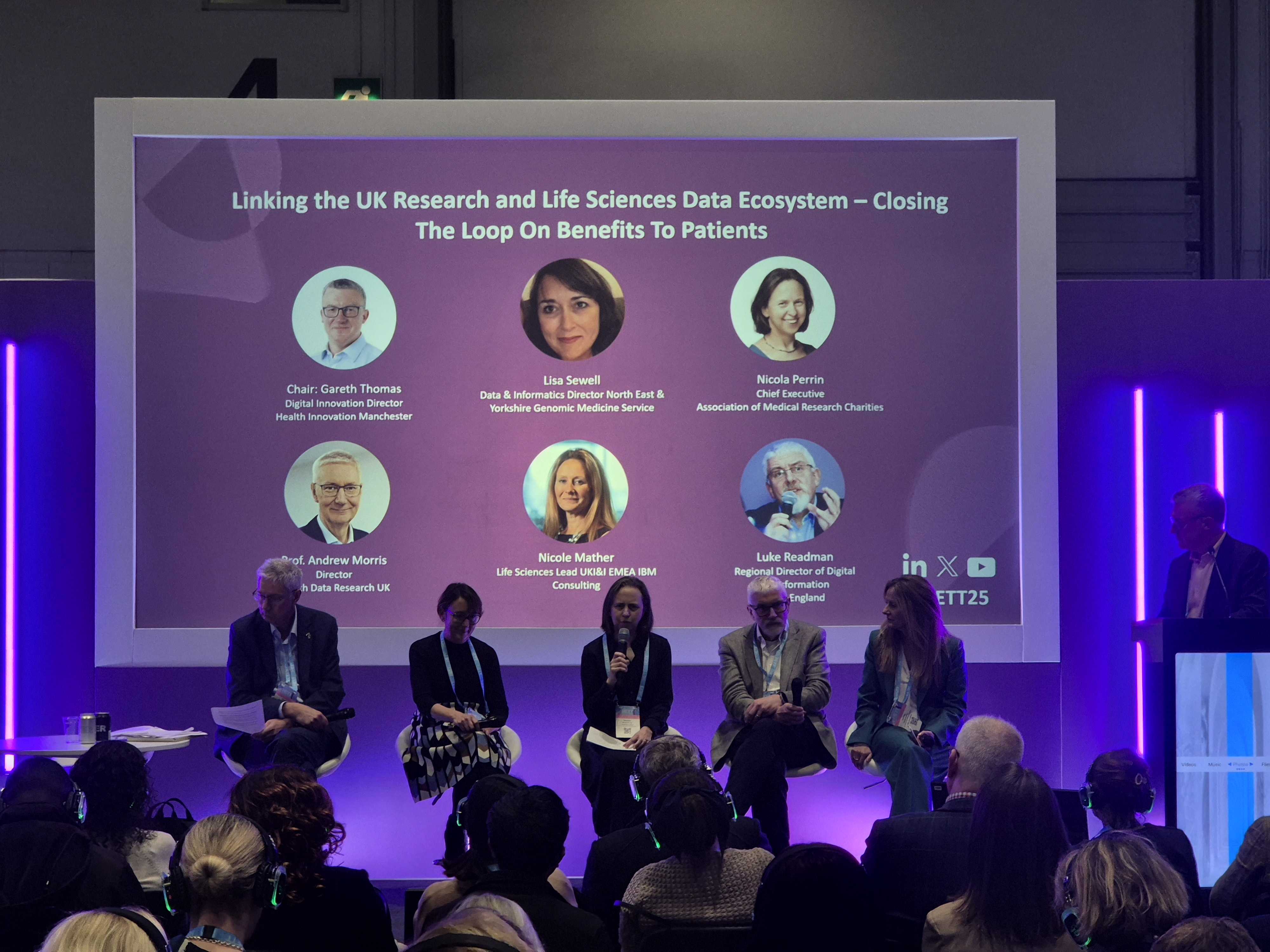Standing in the exhibition hall at HETT 2025, surrounded by the hum of conversation and the buzz of innovation, I found myself reflecting on why conferences like this matter. It's not just about the technology, though there's plenty of that on show. It's about the people trying to make that technology work for real humans, in real healthcare settings, dealing with real constraints.
Over two days, I attended sessions that ranged from the strategic to the deeply practical, and what struck me most was how the challenges discussed aligned so closely with the work we do at TPXimpact. Let me take you through some of the highlights.
The promise and the reality
Sonia Patel's opening keynote set the tone brilliantly. She talked about the NHS's journey from "analogue to digital" as one of the three major shifts in the government's 10-year health plan. What resonated was her honesty about where we are. Yes, we're making progress. Yes, digital is finally centre stage rather than an afterthought. But we're also dealing with fragmented systems, legacy technology, and organisations at wildly different stages of digital maturity.
This is the reality we navigate every day at TPXimpact. When Sonia spoke about moving to "person-centred architecture", designing around people and pathways rather than systems and organisations, it felt like she was describing our Design pillar. We know that understanding complex problems starts with understanding users' needs, not with the technology itself.
The bureaucracy paradox
One of the most engaging panels tackled something everyone's experienced but few want to discuss openly: bureaucracy and red tape. The panel (featuring voices from across the NHS) didn't pull punches. An audience member pointed out that lengthy approval processes can cause people to lose faith in new technology before it's even deployed. The system, as one panellist put it, is "designed for accountability, which stifles innovation."
But here's the thing: they weren't arguing for throwing out governance. They were arguing for smarter governance. Value-based procurement instead of tick-box exercises. Transparent information about requirements. Leadership that's held accountable not just for avoiding risk, but for failing to innovate.
This resonated deeply with our approach to delivery. We don't believe transformation happens through big-bang implementations. It happens through iteration, learning, and building trust with the people who'll actually use these systems. The panel's call for "less haste, more speed" could be our mantra.
When data becomes revenue
Marc Farr's session on research income was genuinely eye-opening. As Chief Analytical Officer at East Kent Hospitals, he made a compelling case for NHS trusts to think differently about the data they hold. Not exploitatively, the governance and ethics considerations were front and centre, but pragmatically. If pharmaceutical companies and research organisations will pay for access to properly anonymised clinical data, and that data can improve patient outcomes, why shouldn't trusts benefit financially?
What struck me was how this requires a completely different skillset from traditional NHS procurement. Marc was refreshingly blunt: "There's a commercial naivety generally within the public sector." The NHS needs to learn to negotiate risk-reward deals, understand intellectual property, and have conversations about value rather than just cost.
This is precisely where our Data & AI pillar comes into play. We help organisations take data out of silos and make it findable, accessible, interoperable, and reusable. But we also understand that data isn't valuable just because it exists; it's valuable when it's properly governed, carefully anonymised, and used to drive real-world improvements in care.
The human side of prevention
Rachel Hope and Rishi Mannan's presentation on digital prevention services reminded me why we do this work. Yes, 40% of the NHS budget goes on preventable diseases. Yes, 2.8 million people are out of work with work-limiting conditions. The numbers are staggering. But behind those statistics are people, individuals who might avoid illness with the right support at the right time.
What I loved about their approach was the emphasis on "Clinical by Design." Not design thinking as a buzzword, but as a genuine methodology where clinical expertise is embedded in software engineering teams from day one. Safety and value aren't bolted on at the end; they're baked in from the start.
Rishi's point about proportionality stuck with me: "Not all risk is created equal." We need to focus clinical safety efforts where they'll have the biggest impact, rather than applying the same heavyweight process to every single change. This is the kind of pragmatic, human-centred thinking that characterises good digital transformation.
The EPR dilemma
The panel on electronic patient records asked a provocative question: why are we stuck in cycles of implementation and optimisation? Derm Ryan from NHS England gave what I thought was the perfect answer: we should be in that cycle. Optimisation isn't failure; it's reality.
When you implement an EPR, you're managing massive transformative change. You can't do everything at once. You deploy a minimum viable product and then continuously improve it based on feedback from the people using it. As Iain O'Neill pointed out, having the agility to respond to emerging innovations (like ambient voice technology) is more important than knowing exactly where you'll be in five years.
This mirrors our approach to Technology at TPXimpact. We're not about big-bang deployments that tick every box on day one. We're about building scalable, high-quality systems that can evolve with an organisation's needs. Modern engineering standards, cloud migration, and automation aren't ends in themselves, but enablers of continuous improvement.
Women's Health: A case study in fragmentation
Katherine Church was on a powerful panel about women's health. The frustration in that room was palpable. Women receive fragmented care, are passed between specialists, and often feel dismissed. There's a lack of high-quality, disaggregated data. Successful pilot programmes don't scale because there's no standardised national blueprint.
The solutions they discussed (better data collection, holistic rather than purely gynaecological approaches, technology that empowers rather than exploits) all require the kind of integrated service design we specialise in. You can't solve these problems with technology alone. You need to understand the service model, the user needs, the data flows, and the cultural barriers all at once.
What this means for us
Walking away from HETT, I felt energised rather than daunted. Yes, the challenges are enormous. Yes, the NHS is dealing with constrained resources, workforce pressures, and legacy systems that would make anyone weep. But there's also a real appetite for change.
What the NHS needs (what Sonia Patel and others are calling for) is partnership rather than transaction. They don't want suppliers who just sell them technology and walk away. They want partners who understand the complexity, who'll work hand-in-hand with them to co-create solutions, who bring expertise in change management alongside technical capability.
That's TPXimpact's sweet spot. Our four pillars (Design, Data, Technology, and Delivery) aren't separate offerings. They're integrated capabilities precisely because we know that's what transformation requires. You can't just drop in a new data platform without understanding how people work. You can't redesign services without the technical capability to deliver them. You can't implement new technology without supporting organisations through the change.
The conversations at HETT reinforced something I already believed: the future of public sector digital transformation isn't about heroic individuals or silver-bullet technologies. It's about teams with diverse skills working in genuine partnership with the organisations they serve. It's about iteration over perfection. It's about building systems that can evolve rather than ossify.
And perhaps most importantly, it's about never losing sight of why we're doing this. Behind every data platform, every EPR optimisation, every prevention service, there are real people whose lives we might improve.
Our recent insights
Transformation is for everyone. We love sharing our thoughts, approaches, learning and research all gained from the work we do.
-

Unlocking the benefits of AI for charities
Read insight -

What's the future for open data in the UK?
Read insight -

-


